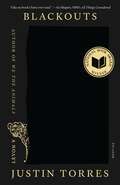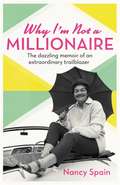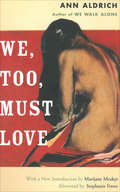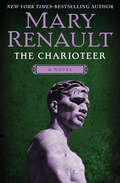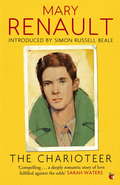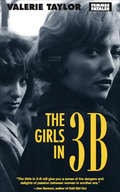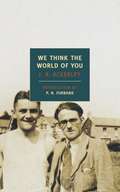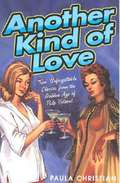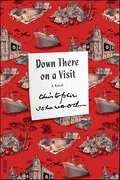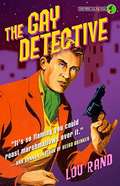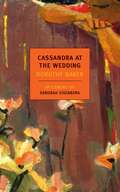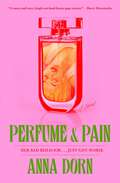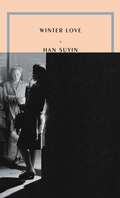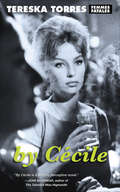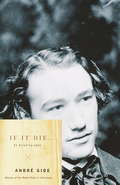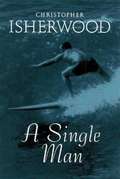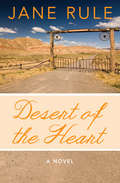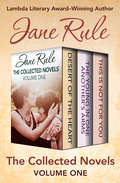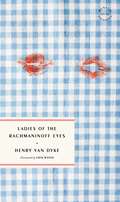- Table View
- List View
Blackouts: A Novel
by Justin TorresWinner of the National Book AwardWinner of the California Book AwardWinner of Tournament of BooksOut in the desert in a place called the Palace, a young man tends to a dying soul, someone he once knew briefly but who has haunted the edges of his life: Juan Gay. Playful raconteur, child lost and found and lost, guardian of the institutionalized, Juan has a project to pass along, one built around a true artifact of a book—Sex Variants: A Study of Homosexual Patterns—and its devastating history. This book contains accounts collected in the early twentieth century from queer subjects by a queer researcher, Jan Gay, whose groundbreaking work was then co-opted by a committee, her name buried. The voices of these subjects have been filtered, muted, but it is possible to hear them from within and beyond the text, which, in Juan’s tattered volumes, has been redacted with black marker on nearly every page. As Juan waits for his end, he and the narrator recount for each other moments of joy and oblivion; they resurrect loves, lives, mothers, fathers, minor heroes. In telling their own stories and the story of the book, they resist the ravages of memory and time. The past is with us, beside us, ahead of us; what are we to create from its gaps and erasures?A book about storytelling—its legacies, dangers, delights, and potential for change—and a bold exploration of form, art, and love, Justin Torres’s Blackouts uses fiction to see through the inventions of history and narrative. A marvel of creative imagination, it draws on testimony, photographs, illustrations, and a range of influences as it insists that we look long and steadily at what we have inherited and what we have made—a world full of ghostly shadows and flashing moments of truth. A reclamation of ransacked history, a celebration of defiance, and a transformative encounter, Blackouts mines the stories that have been kept from us and brings them into the light.
The Well Of Loneliness
by Radclyffe HallOriginally published in 1928, Radclyffe Hall's The Well of Loneliness is the timeless story of a lesbian couple's struggle to be accepted by "polite" society. When an unconventional woman named Stephen Gordon falls in love with an ingenue named Mary, their love affair gives Stephen her first taste of happiness. However, the pleasure the lovers find in each other is quickly tarnished by the disapproval of friends and family who refuse to welcome the "scandalous" couple in their homes. But the most difficult test of the women's love for each other comes when a young man offers to give Mary the "respect-ability" that Stephen can not. The Well of Loneliness is the thinly disguised story of Radclyffe Hall's own life. Shockingly candid for its time, this novel was the very first to condemn homophobic society for its unfair treatment of gays and lesbians. Banned outright in 1928, its publication marked an act of great courage which almost ruined Hall's literary career. Although half a century has passed since its initial publication, the issues of prejudice and persecution that Radclyffe Hall addresses remain sadly relevant today
Why I'm Not A Millionaire: The dazzling memoir of an extraordinary trailblazer
by Nancy SpainThe superb classic memoir from a dazzlingly eccentric and endlessly fascinating author - a woman very much ahead of her time.'She was bold, she was brave, she was funny, she was feisty. I owe her a great deal in leading the way' Sandi ToksvigNancy Spain was one of the most celebrated - and notorious - writers and broadcasters of the 40s, 50s and 60s. Hilarious, controversial and brilliant, she lived openly as a lesbian (sharing a household with her two lovers and their various children) and was frequently litigated against for her newspaper columns - Evelyn Waugh successfully sued her for libel... twice. She was also a fantastic crime novelist (and according to the Guardian, one of the 50 best female crime thriller writers of all time) writing with a unique style that marries the acid wit of Dorothy Parker with the intricacy of plotting worthy of Agatha Christie. WHY I AM NOT A MILLIONAIRE, has the same wit, style and fascinating detail - first published in 1956, with an introductory note from Noel Coward. After her death in a plane crash in 1964, Noel Coward commented: 'It is cruel that all that gaiety, intelligence and vitality should be snuffed out, when so many bores and horrors are left living.'
The Immoralist
by André Gide Dorothy Bussy"Knowing how to free oneself is nothing; the difficult thing is knowing how to live with that freedom" is a central lesson in this short novel, which explores themes of life versus death, mind versus body, and the process of self-discovery.<P> This is the story of the rebellion of a mind against the morality of self-sacrifice and the ordinary civilized standards of personal conduct.<P> Translated from the French: "L'Immoraliste".
We, Too, Must Love
by Ann AldrichA literary lesbian landmark that &“will transport today&’s readers . . . to the 1950s homosexual scene&” (Marcia M. Gallo, author of Different Daughters). Three years after the publication of her groundbreaking 1955 bestseller, We Walk Alone, Ann Aldrich expanded on her journalistic portraits of lesbian subcultures in and around New York, in We, Too, Must Love. Inspired by the hundreds of letters she received by women from around the country (many reprinted here), Aldrich tackled questions of class division; explored the diverse careers lesbians held; guided readers through the social cliques and bar scenes; set the record straight on gay stereotypes; observed the differences among the &“Village,&” &“Uptown,&” and Brooklyn lesbian communities; and hinted at the growing consciousness that would fuel later lesbian and gay rights movements. We Walk Alone and We, Too, Must Love are, in effect, &“indispensable guides to a hidden world&” (Advocate.com). &“Simultaneously intimate and investigative, subjective and discerning&” (UTNE Magazine), &“Aldrich touched innumerable lives and gave hope to lesbians mired in a harsh and ignorant era. Read these books to learn what it was like back then, what we believed and how we made a start in the struggle against prejudice.&” —Ann Bannon, author of The Beebo Brinker Chronicles
The Charioteer: A Novel (Virago Modern Classics Ser. #84)
by Mary RenaultA WWII soldier embarks on affairs with two very different men in a landmark novel that &“transcends categorizations&” (The Telegraph). After being wounded at Dunkirk in World War II, Laurie Odell is sent back home to a rural British hospital. Standing out among the orderlies is Andrew, a bright conscientious objector raised as a Quaker. The unspoken romance between the two men is tested when Ralph, a friend of Laurie&’s from school, re-enters his life, introducing him into a milieu of jaded, experienced gay men. Will Laurie reconcile himself to Ralph&’s embrace, or can he offer Andrew the idealized, Platonic intimacy he yearns for? This novel has been called one of the foundation stones of gay literary fiction, ranking alongside James Baldwin&’s Giovanni&’s Room and Gore Vidal&’s The City and the Pillar. Celebrated for its literary brilliance and sincere depiction of complex human emotions, The Charioteer is a stirring and beautifully rendered portrayal of love. This ebook features an illustrated biography of Mary Renault including rare images of the author.
The Charioteer: A Virago Modern Classic (Vmc Ser. #84)
by Mary Renault'The Charioteer remains compelling both as a snapshot of a particular - and particularly fascinating - cultural moment, and as a deeply romantic story of love fulfilled against the odds. It has all those qualities that make Mary Renault so memorable as a novelist: craft, subtlety, intelligence, and a terrific natural sympathy with the intricacies of honour and desire' SARAH WATERS'An explosive and courageous book' SIMON RUSSELL BEALEFirst published in 1953, The Charioteer is a tender, intelligent coming-of-age novel and a bold, unapologetic portrayal of homosexuality that stands with Gore Vidal's The City and the Pillar and James Baldwin's Giovanni's Room as a landmark work in gay literature.Injured at Dunkirk, Laurie Odell, a young corporal, is recovering at a rural veterans' hospital. There he meets Andrew, a conscientious objector serving as an orderly, and the men find solace in their covert friendship. Then Ralph Lanyon appears, a mentor from Laurie's schooldays. Through him, Laurie is drawn into a tight-knit circle of gay men for whom liaisons are fleeting and he is forced to choose between the ideals of a perfect friendship and the pleasures of experience.'Emotionally intelligent, beautifully written and deeply moving, it transcends categorisations' Telegraph
The Girls in 3-B (Femmes Fatales)
by Valerie Taylor Tania ModleskiAnnice, Pat, and Barby are best friends from Iowa, freshly arrived in booming 1950s Chicago to explore different paths toward independence, self--expression, and sexual freedom. From the hip-hang of a bohemian lifestyle to the sophisticated lure of romance with a handsome, wealthy, married boss to the happier security of a lesbian relationship, these three experience firsthand the dangers and limitations of women's economic -reliance on men. Well-known lesbian pulp author Valerie Taylor skillfully paints a sociological portrait of the emotional and economic pitfalls of heterosexuality in 1950s America-and then offers a defiantly subversive alternative. A classic pulp tale showcasing predatory beatnik men, drug hallucinations, and secret lesbian trysts, The Girls in 3-B approaches the theme of sex from the stiffened vantage point of 1950s psychology.Femmes Fatales restores to print the best of women's writing in the classic pulp genres of the mid-20th century. From mystery to hard-boiled noir to taboo lesbian romance, these rediscovered queens of pulp offer subversive perspectives on a turbulent era. Enjoy the series: Bedelia; The Blackbirder; Bunny Lake Is Missing; By Cecile; The G-String Murders; The Girls in 3-B; In a Lonely Place; Laura; Mother Finds a Body; Now, Voyager; Skyscraper; Stranger on Lesbos; Women's Barracks.
We Think The World of You
by J. R. Ackerley P. N. FurbankWe Think the World of You combines acute social realism and dark fantasy, and was described by J.R. Ackerley as "a fairy tale for adults." Frank, the narrator, is a middle-aged civil servant, intelligent, acerbic, self-righteous, angry. He is in love with Johnny, a young, married, working-class man with a sweetly easygoing nature. When Johnny is sent to prison for committing a petty theft, Frank gets caught up in a struggle with Johnny's wife and parents for access to him. Their struggle finds a strange focus in Johnny's dog--a beautiful but neglected German shepherd named Evie. And it is she, in the end, who becomes the improbable and undeniable guardian of Frank's inner world.
Another Kind Of Love
by Paula ChristianUnlike most pulp romances of the 1950s and '60s, Paula Christian's heroines were thoroughly modern women--struggling to define themselves while searching for their own lasting relationships. Fully human and honest, afraid of failure yet always hopeful, these sisters were blazing a trail, encouraging others on their path to...<P> Another Kind Of Love<P> The moment Laura Garraway shares a forbidden kiss with beautiful Hollywood starlet Ginny Adams, she discovers the missing piece of herself. When fame-hungry Ginny won't leave her powerful movie star lover, Saundra, Laura runs away to New York's comforting bright lights, desperate to forget her. There, in the cigarette-and-martini-drenched gay bars of the Village, and the offices of Madison Avenue, Laura finds herself in a new world--one in which who she is and what she wants are completely up to her...<P> Love Is Where You Find It
Down There on a Visit: A Novel (Fsg Classics Ser.)
by Christopher IsherwoodConsisting of four accounts of encounters with four male characters, each of them visited by a different Christopher Isherwood, and each set in a different time and place—Berlin in the 1920s (overlapping the time period of the Berlin Stories), the Greek Isles in the early 1930s, London in the late 1930s and California in 1940—this acclaimed novel explores Isherwood's fundamental concerns with the choice of a way of life, and its implications for love, sex, spirituality and self-fulfillment. Published in 1959, when Isherwood had already become something of a literary rock star, Down There on a Visit is a very funny but also sad and deeply personal book that charts Isherwood's life of carnal indulgence and his first interlude with what would become a serious involvement with Eastern mysticism.
The Gay Detective
by Lou RandBefore there was Armistead Maupin's Tales of the City, vintage pulp writer Lou Rand delivered this high-camp masterpiece in 1961. Set in Beat-era "gay mecca-in-the-making" San Francisco, the novel's tightly-knit plot boasts a sissy gumshoe, his butch ex-marine assistant, a nymphomaniac on the make, and plenty of dishy humor.
The Tree and the Vine
by Dola De Jong Nona KinzerBea and Erica meet in 1938, before Germany has come to power. Bea, who has had very few, but mostly violent sexual encounters in the past, finds herself attracted to the boyish Erica. However, the coming years will be hard on the women, as Hitler's forces draw ever nearer to the land they call home.
Cassandra at the Wedding
by Deborah Eisenberg Dorothy BakerCassandra Edwards is a graduate student at Berkeley: gay, brilliant, nerve-racked, miserable. At the beginning of this novel, she drives back to her family ranch in the foothills of the Sierras to attend the wedding of her identical twin, Judith, to a nice young doctor from Connecticut. Cassandra, however, is hell-bent on sabotaging the wedding. Dorothy Baker's entrancing tragicomic novella follows an unpredictable course of events in which her heroine appears variously as conniving, self-aware, pitiful, frenzied, absurd, and heartbroken--at once utterly impossible and tremendously sympathetic. As she struggles to come to terms with the only life she has, Cassandra reckons with her complicated feelings about the sister who she feels owes it to her to be her alter ego; with her father, a brandy-soaked retired professor of philosophy; and with the ghost of her dead mother. First published in 1962, Cassandra at the Wedding is a book of enduring freshness, insight, and verve. Like the fiction of Jeffrey Eugenides and Jhumpa Lahiri, it is the work of a master stylist with a profound understanding of the complexities of the heart and mind.
Perfume and Pain: A Novel
by Anna Dorn&“Perceptive and witty—like a Sally Rooney novel set in Southern California.&” —Star Tribune (Minneapolis) &“It&’s this author&’s best work yet. A Sapphic roller-coaster ride.&” —Kirkus Reviews (starred review) A controversial LA author attempts to revive her career and finally find true love in this hilarious nod to 1950s lesbian pulp fiction.Having recently moved both herself and her formidable perfume bottle collection into a tiny bungalow in Los Angeles, mid-list author Astrid Dahl finds herself back in the Zoom writer&’s group she cofounded, Sapphic Scribes, after an incident that leaves her and her career lightly canceled. But she temporarily forgets all that by throwing herself into a few sexy distractions—like Ivy, a grad student researching 1950s lesbian pulp who smells like metallic orchids, or her new neighbor, Penelope, who smells like patchouli. Penelope, a painter living off Urban Outfitters settlement money, immediately ingratiates herself in Astrid&’s life, bonding with her best friends and family, just as Astrid and Ivy begin to date in person. Astrid feels judged and threatened by Penelope, a responsible older vegan, but also finds her irresistibly sexy. When Astrid receives an unexpected call from her agent with the news that actress and influencer Kat Gold wants to adapt her previous novel for TV, Astrid finally has a chance to resurrect her waning career. But the pressure causes Astrid&’s worst vice to rear its head—the Patricia Highsmith, a blend of Adderall, alcohol, and cigarettes—and results in blackouts and a disturbing series of events. Unapologetically feminine yet ribald, steamy yet hilarious, Anna Dorn has crafted an exquisite homage to the lesbian pulp of yore, reclaiming it for our internet and celebrity-obsessed world. With notes of Southern California citrus and sultry smokiness, Perfume and Pain is a satirical romp through Hollywood and lesbian melodrama.
Winter Love
by Suyin HanThe raw account of a life-altering affair in wartime London—&“Han Suyin&’s outstanding achievement . . . her finest novel.&” (Alison Hennegan)As a college student in London during the bitterly cold winter of 1944, Red falls in love with her married classmate Mara. Their affair unleashes a physical passion, a jealousy, and a sense of self-doubt that sweep all her previous experiences aside and will leave her changed forever. Set against the rubble of the bombed city, in a time of gray austerity and deprivation, Winter Love recalls a life at its most vivid. &“Probably the best thing she has ever written&” (Daily Telegraph), it is also Han Suyin&’s most unexpected, tender, and stirring work.
By Cécile (Femmes Fatales)
by Tereska TorresA coming of age novel set in post-war France by an author who &“launched the modern genre of the lesbian paperback&” (Susan Stryker, author of Queer Pulp). When eighteen-year-old Cécile is orphaned at the end of World War II, the curious and adventurous Catholic student finds refuge in Paris, and with an older man. A former member of the Resistance with Cécile&’s parents, Maurice is handsome, a thrilling cultured patron of the arts, and a mentor eager to introduce the budding young author to his intimate circle of friends—Cocteau, Sartre, and Eartha Kitt! As liberating an influence as he is, Maurice also encourages Cécile to shed her inhibitions he sees as bourgeois. Possessing a sensual and passionate temperament, Cécile is eager to begin exploring—by sharing Maurice&’s mistress, and writing of every life-changing and delightfully scandalous new experience. Credited with penning the first, candidly lesbian novel—Women&’s Barracks, in 1950—Tereska Torrès &“scandalized mid-century America&” (The New York Times). In By Cécile, written in 1963, &“Madame Torres has re-imagined a youthful Colette (here called Cécile) in the infinitely seductive post-World War II period in Paris, where she moves like a sleeping princess through the perverse fairy tales of man-made cafe society. [It&’s] a sharply perceptive novel&” (Joan Schenkar, author of The Talented Miss Highsmith).
If It Die
by Andre GideThis is the major autobiographical statement from Nobel laureate André Gide. In the events and musings recorded here we find the seeds of those themes that obsessed him throughout his career and imbued his classic novels The Immoralist and The Counterfeiters. Gide led a life of uncompromising self-scrutiny, and his literary works resembled moments of that life. With If It Die, Gide determined to relay without sentiment or embellishment the circumstances of his childhood and the birth of his philosophic wanderings, and in doing so to bring it all to light. Gide's unapologetic account of his awakening homosexual desire and his portrait of Oscar Wilde and Lord Alfred Douglas as they indulged in debauchery in North Africa are thrilling in their frankness and alone make If It Die an essential companion to the work of a twentieth-century literary master.
A Single Man
by Christopher IsherwoodWhen A Single Man was originally published, it shocked many by its frank, sympathetic, and moving portrayal of a gay man in midlife. George, the protagonist, is adjusting to life on his own after the sudden death of his partner, and determines to persist in the routines of his daily life; the course of A Single Man spans twenty-four hours in an ordinary day. An Englishman and a professor living in suburban Southern California, he is an outsider in every way, and his internal reflections and interactions with others reveal a man who loves being alive despite everyday injustices and loneliness. Wry, suddenly manic, constantly funny, surprisingly sad, this novel catches the texture of life itself.
Desert of the Heart: A Novel (Virago Modern Classics Ser.)
by Jane Rule&“A landmark work of lesbian fiction&” and the basis for the acclaimed film Desert Hearts (The New York Times). Against the backdrop of Reno, Nevada, in the late 1950s, award-winning author Jane Rule chronicles a love affair between two women. When Desert of the Heart opens, Evelyn Hall is on a plane that will take her from her old life in Oakland, California, to Reno, where she plans to divorce her husband of sixteen years. A voluntary exile in a brave new world, she meets a woman who will change her life. Fifteen years younger, Ann Childs works as a change apron in a casino. Evelyn is instantly drawn to the fiercely independent Ann, and their friendship soon evolves into a romantic relationship. An English professor who had always led a conventional life, Evelyn suddenly finds all her beliefs about love, morality, and identity called into question. Peopled by a cast of unforgettable characters, this is a novel that dares to ask whether love between two women can last.
The Collected Novels Volume One: Desert of the Heart, The Young in One Another's Arms, and This Is Not for You
by Jane RuleThree beautiful novels from the groundbreaking, award-winning author—including &“a landmark work of lesbian fiction&” and basis for the film Desert Hearts (The New York Times). First published in 1964, Desert of the Heart broke ground with its realistic and complex portrayal of love between two women, and immediately established Jane Rule&’s reputation as an &“extraordinary writer—perhaps the most significant lesbian fiction writer of the twentieth century&” (Katherine V. Forrest). Desert of the Heart: Rule&’s debut novel is set in 1950s Reno, Nevada, where English professor Evelyn Hall has come for a quick divorce from her husband. There she meets Ann Childs, fifteen years her junior, who works as a change apron in a casino. As their friendship deepens into a romantic relationship, Evelyn&’s preconceptions about love, morality, and identity are challenged. &“An intelligent and utterly believable novel.&” —Joyce Carol Oates The Young in One Another&’s Arms: In Ruth Wheeler&’s Vancouver rooming house during the Vietnam War, an eclectic assortment of misfits, dropouts, deserters, and radicals become each other&’s chosen family. When developers threaten the property, the community is challenged to find a new home on Galiano Island. &“[A] mature and satisfying work.&” —Bay Area Reporter This Is Not for You: Through a decades-long correspondence between Katherine and Esther, the woman with whom she falls passionately in love, Rule&’s second novel follows a group of friends living in New York and abroad as they explore the freedoms—and limitations—of their sexuality, as the repressed fifties gives way to the liberated sixties. &“A beautiful, ironic, civilized novel.&” —Margaret Lawrence
Ladies of the Rachmaninoff Eyes
by Henry Van DykeA lost midcentury classic—the farcical misadventures of a queer Black teen sharing a house with two adoptive mothers, a lascivious cook, and a reticent ghost.In a small Michigan town, in the late 1950s, the widow Etta Klein—wealthy and Jewish—has for more than thirty years relied for aid, comfort, and companionship on her Black housekeeper Harriet Gibbs. Between &“Aunt Harry&” and Etta, a relationship has developed that is closer than a friendship, yet not quite a marriage. They are inseparable, at once absurdly unequal and defined by a comic codependence. Forever mourning the early death of her favorite son, Sargent, Etta has all but adopted Aunt Harry&’s nephew, the precocious, gay seventeen-year-old Oliver, who has been raised by both women. Oliver is facing down his departure to college—and fending off the advances of Etta&’s cook, Nella Mae—when the household is disrupted by the arrival of a self-proclaimed &“warlock,&” one Maurice LeFleur, who has convinced Etta and Harry that he might be able to contact Sargent in the afterlife . . . Ladies of the Rachmaninoff Eyes was the debut of the extraordinary Henry Van Dyke, whose witty and outrageous novels look back to the sparkling, elaborate comedies of Ronald Firbank and forward to postmodern burlesques like Fran Ross&’s Oreo. There is nothing else quite like them in American fiction.
